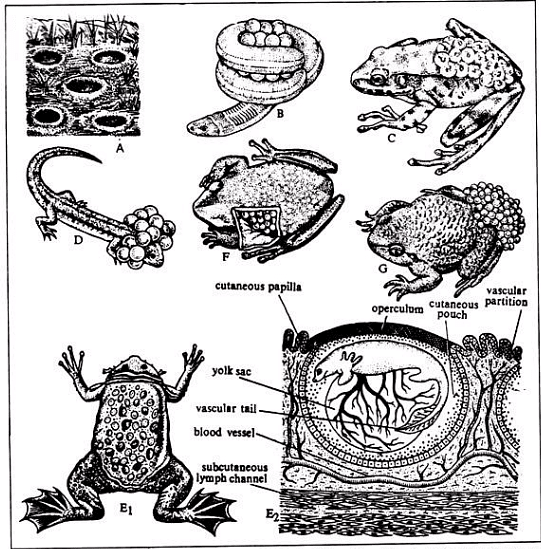Amphibia: Parental Care | Zoology Optional Notes for UPSC PDF Download
Parental Care in Amphibians: Pioneers of Land Invasion
Amphibians, as the trailblazers among vertebrates in venturing onto land, confronted a multitude of challenges in their newfound environment. To thrive in this novel setting, they ingeniously devised diverse strategies to overcome adversities. A paramount emphasis naturally lay on ensuring the continuity of their species, with the reproductive mechanism undergoing substantial modifications.
- The perpetuation of the species could be achieved either through the prolific production of eggs or the attentive care of a limited number of eggs. The nurturing or care of offspring signifies a noteworthy accomplishment in the trajectory of evolution. It would be inaccurate to consider the care of young ones as an exclusive domain of mammals.
- While parental care has achieved perfection in mammals, it is noteworthy that amphibians exhibit a well-developed phenomenon of parental care. This is characterized by profound alterations in both structure and behavior. Parental care primarily involves modifications in parental behaviors to ensure the well-being of offspring, allowing the continuation of the species with a limited number of eggs.
- Instances of such care are evident, such as the female Icthyophis rolling around its eggs, Alytes carrying eggs on her back, and Gastrotheca, also known as the New World brooding or Marsupial frog, possessing a specialized pouch for the transfer and development of fertilized eggs.

In amphibians, parental care manifests itself in diverse ways, reflecting the adaptability of these creatures to their environments.
Selection of Nesting Sites in Amphibians: Strategies and Adaptations
- Careful Site Selection: Certain frogs and toads exhibit a distinctive approach to caring for their eggs, focusing primarily on the selection of suitable nesting sites. In the case of Rhacophorus schlegli from Japan, eggs are deposited in holes on muddy banks near rivers or ponds. To shield the eggs from desiccation, a protective layer of foamy mucus is applied (Fig. 7.48B). Subsequently, rainwater washes the eggs into the water, initiating their developmental journey.
- In Gyrinophilus, eggs find refuge beneath stones in streams. The secretions on their bodies prevent the growth of fungi. Additionally, species like Hylodes lay eggs on the undersides of leaves suspended above water.
- Frothing of Water: Certain anurans adopt a frothing strategy (Fig. 7.48B) immediately after laying eggs. Through a coordinated wriggling movement of hind limbs, the surrounding water becomes frothy. This serves a dual purpose – preventing egg desiccation and avoiding detection by potential predators. Both male and female frogs actively engage in this process.
- Formation of Foam Nests: As proposed by Mallick, Mallick, and Das (1980), Polypedates (Rhacophorus) maculatus secretes a jelly-like substance with eggs intermittently. The female's hind limbs create a cross-wise movement, resulting in the formation of a small frothy mass, resembling an irregular ball. Upon the separation of partners, the frothy mass transitions from white to yellowish. This structure, known as a foam nest, exhibits gradual outer surface hardening and can endure for days.
These foam nests are observed in various locations, such as leafy branches, spaces between leaves over water, grass beds near water, and on the leaves of floating water hyacinth (Fig. 7.46). In India, recorded instances include R. maculatus by Ferguson (1904), Annandale (1912), and Mallick et al. (1980), as well as Rhacophorus leucomystax by Annandale (1912) and R. malabaricus by Ferguson (1904). Reports from Bhaduri (1932, 1953) and Okada (1928) further confirm the presence of foam nests in Rhacophorus.
Diverse Nest-Building Strategies in Amphibians
Parental Construction of Nests: Following the deposition of eggs, amphibian parents exhibit nurturing behavior by constructing nests to safeguard their developing offspring. These nests can be categorized into three distinct types:1. Mud Nest:
- Example: Hyla Faber (Habitat – Brazil)
- In the case of Hyla Faber, parents carve a small hole in the mud to accommodate the developing eggs. The surplus mud functions as a protective wall (Fig. 7.47A).
- Example: Phyllomedusa (Fig. 7.48A)
- South American tree-frog Phyllomedusa employs a leaf nest construction method. This involves folding the margins of leaves and bonding them together using cloacal secretion. The nest features an aperture at the base and extends over a watery area.
- Example: Triton
- Triton adopts a unique approach by constructing shoot nests. This involves securing the eggs on tree shoots where the young amphibians undergo development. The entire nest remains enveloped in a gelatinous secretion, offering protective coverage.
These diverse nesting strategies underscore the resourcefulness of amphibians in adapting to different environments and highlight the significance of parental care in ensuring the survival of their progeny.
Unique Amphibian Parental Strategies: Carrying Eggs on the Body
1. Hyla goeldii:
- Carrying Eggs on the Back
- In Hyla goeldii (Fig. 7.48D), female frogs exhibit an innovative approach by carrying eggs on their backs within incipient brood pouches. The offspring emerge as fully developed frogs, albeit with tails.
- Male-Assisted Egg Discharge
- Male midwife toads, Alytes obstetricians, found abundantly in France and Italy, engage in a peculiar form of parental care. Multiple males gather around a female on land, with one successfully grasping the female's waist. The male massages and lubricates the female's cloacal region, prompting egg discharge. Fertilization occurs during egg expulsion, after which the male wraps the eggs around his thigh and retreats to a hole near the pond. Upon hatching readiness, the male carries the eggs to the nearest water body, where larvae emerge. Subsequent development and metamorphosis transpire in water (Fig. 7.47G).
- Egg Carriage on Females' Backs
- In species like Pipa pipa and Cryptobatrachus evansi (Fig. 7.44C), females carry eggs on their backs. The soft, spongy skin on the dorsal side forms pockets in which eggs are lodged (Fig. 7.47E1). During the breeding season, the dorsal skin of females becomes soft, spongy, and gelatinous. Males place eggs on the female's back, each sinking into a small pit. An operculum, developed from the remnant of the egg envelop and integumentary secretion, covers the pit. Development occurs inside these cutaneous pits, marked by highly vascularized partitions. The developing larva attains a vascular tail (Fig. 7.47E2), and physiological material exchange between embryonic and maternal tissues is suggested. The tadpole larva emerges approximately 80 days after egg deposition.
- Brood Pouch with Slit-Like Opening
- In Nototrema (= Gastrotheca) pygmaeum (Fig. 7.47F), a few eggs develop in the brood pouch, featuring a small slit-like opening in the posterior side. Nototrema marsupiata sees the young tadpoles hatch, while in N. oviferum, metamorphosis is fully completed inside the brood pouch. These adaptations illustrate the diversity of parental care strategies among amphibians.

Transporting Larvae and Unique Reproductive Adaptations
1. Arthroleptis - Larval Transportation:- Male-Carried Larvae
- In Arthroleptis, larvae attach to males and are transported from one pond to another. As a protective measure during danger, the larvae can be harbored inside the buccal cavity.
- Egg Placement Strategies
- In oviparous caecilians, like Ichthyophis, the body coils around the egg mass to guard them until hatching (7.40). Conversely, ovoviviparous caecilian Ceotrypetes employs a different approach. Yolky eggs migrate to the last part of the oviducts. Upon exhaustion of the yolk and atrophy of external gills, embryos hatch, remaining inside the oviducts until they reach approximately 75 mm in length. Nutrition is provided through uterine 'milk,' and metabolic exchanges occur between vascular maternal and fetal tissues.
- Swallowed Eggs in the Vocal Sac
- In Rhinoderma darwini (Fig. 7.48E), males swallow eggs, placing them inside the inflated vocal sac. The eggs may stay there until hatching or even until the completion of metamorphosis.
- Uterine Egg Placement
- Salamandra atra and S. maculosa exhibit extreme modifications with eggs placed inside the uterine cavity. The entire tadpole hood develops within. Two eggs are laid at a time, and larvae remain attached to the uterine wall by a membrane, functioning in a primitive placental manner. The broad, vascular tail facilitates metabolic exchanges.

- The diverse strategies discussed illustrate how parental care is implemented in different amphibian species. Comparisons between amphibian and mammalian parental care raise intriguing questions about evolutionary parallels.
- Experimental evidence regarding the controlling mechanisms of parental care in amphibians remains limited. The evolution of parental care in amphibians is likely influenced by their habits and environments.
- Two alternative explanations are proposed:
- (a) Parental care is primarily behavioral and mechanical, possibly influenced by hormonal actions.
- (b) Parental care is instinctive or a result of reflex actions developed during the breeding season, suggesting that care for eggs or young is predominantly, if not purely, instinctive in nature.
|
181 videos|346 docs
|
FAQs on Amphibia: Parental Care - Zoology Optional Notes for UPSC
| 1. What is parental care in amphibians? |  |
| 2. What are the nesting site selection strategies in amphibians? |  |
| 3. How do amphibians carry their eggs on their bodies? |  |
| 4. What are some diverse nest-building strategies in amphibians? |  |
| 5. What are some unique reproductive adaptations in amphibians? |  |

|
Explore Courses for UPSC exam
|

|

















